Business Context and Management: Industry Trend Analysis for Tesco PLC
VerifiedAdded on 2022/12/14
|12
|3370
|352
Report
AI Summary
This report provides a comprehensive industry trend analysis of Tesco PLC, focusing on its business context within the UK retail sector. It begins with an introduction highlighting the challenges faced by the retail industry due to the COVID-19 pandemic and Tesco's strategies to maintain its market ...
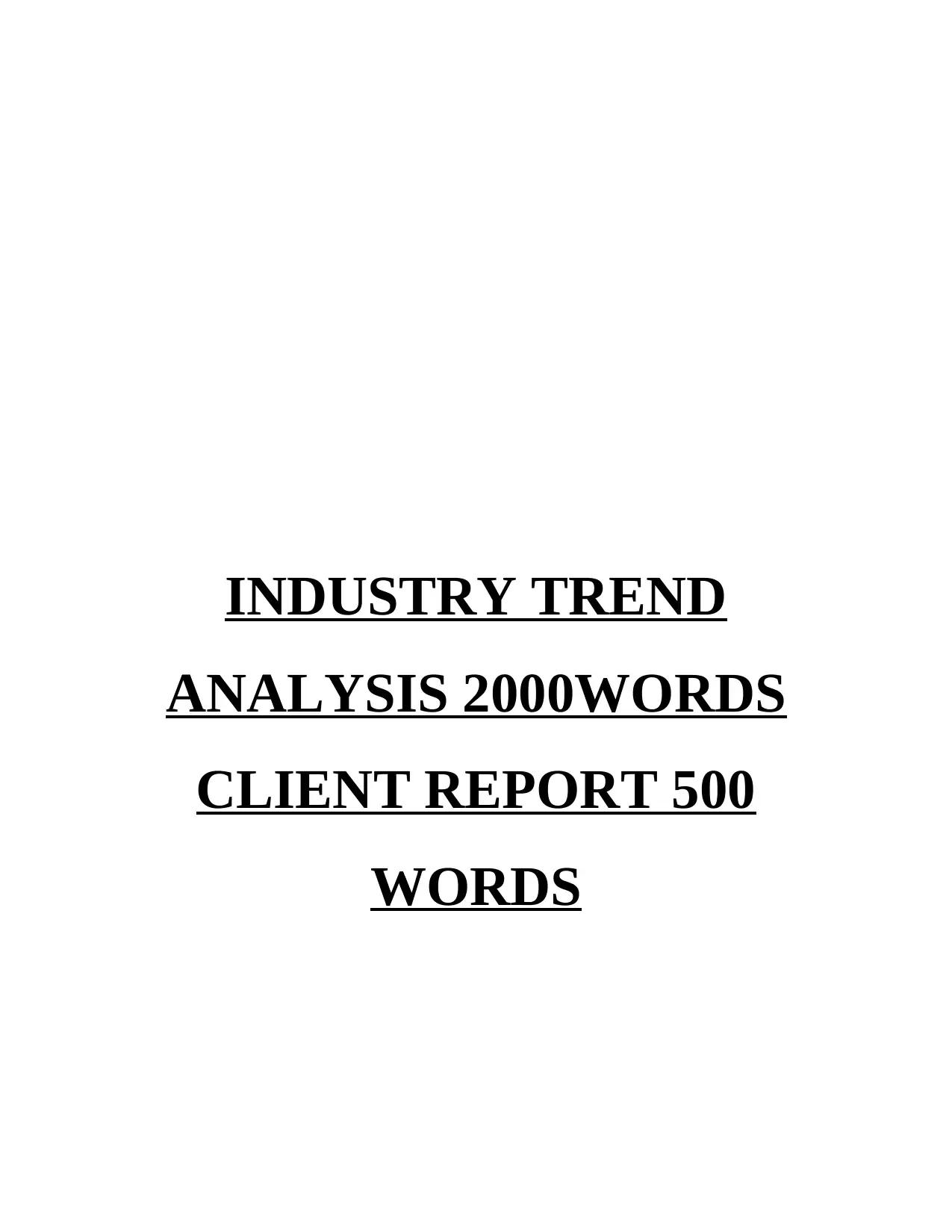
INDUSTRY TREND
ANALYSIS 2000WORDS
CLIENT REPORT 500
WORDS
ANALYSIS 2000WORDS
CLIENT REPORT 500
WORDS
Paraphrase This Document
Need a fresh take? Get an instant paraphrase of this document with our AI Paraphraser
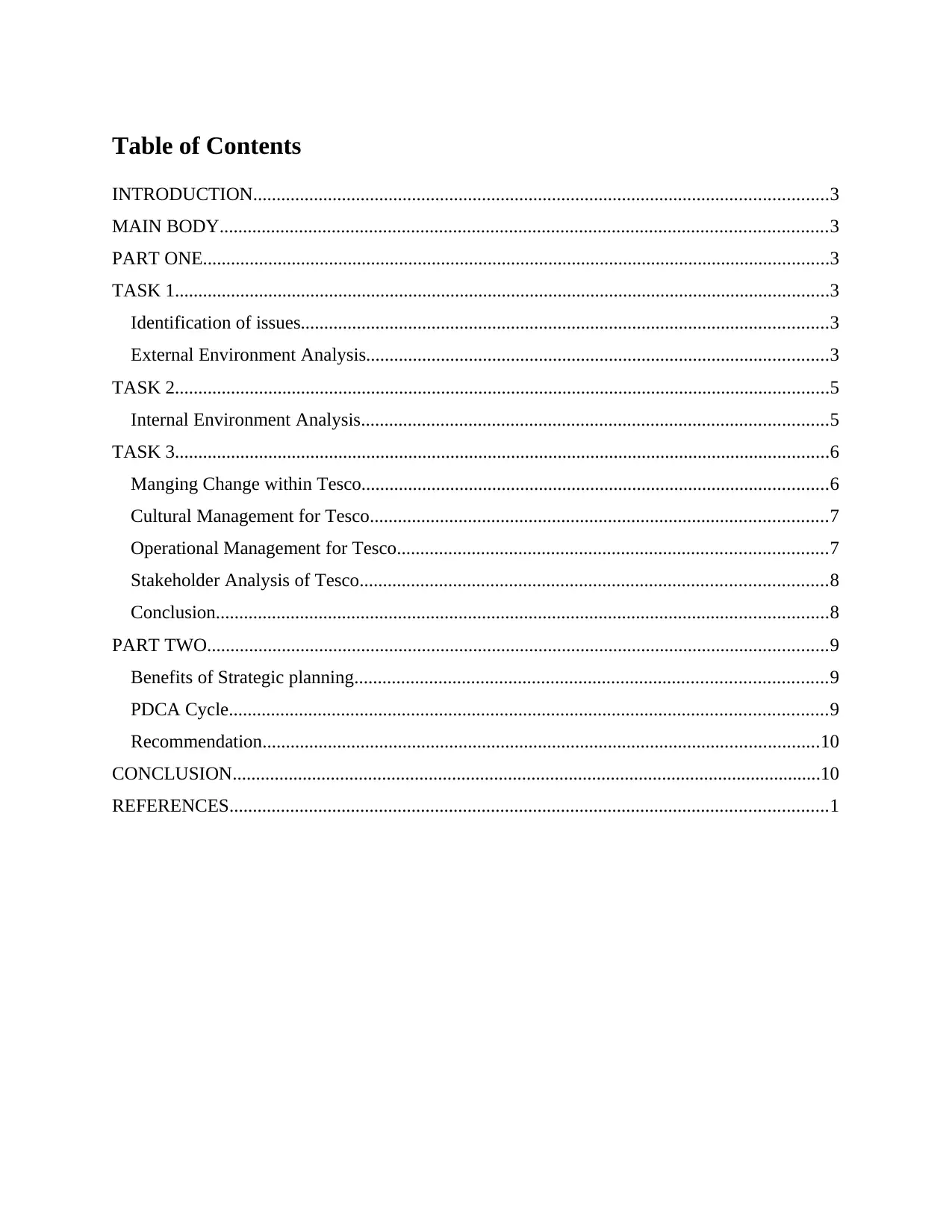
Table of Contents
INTRODUCTION...........................................................................................................................3
MAIN BODY..................................................................................................................................3
PART ONE......................................................................................................................................3
TASK 1............................................................................................................................................3
Identification of issues.................................................................................................................3
External Environment Analysis...................................................................................................3
TASK 2............................................................................................................................................5
Internal Environment Analysis....................................................................................................5
TASK 3............................................................................................................................................6
Manging Change within Tesco....................................................................................................6
Cultural Management for Tesco..................................................................................................7
Operational Management for Tesco............................................................................................7
Stakeholder Analysis of Tesco....................................................................................................8
Conclusion...................................................................................................................................8
PART TWO.....................................................................................................................................9
Benefits of Strategic planning.....................................................................................................9
PDCA Cycle................................................................................................................................9
Recommendation.......................................................................................................................10
CONCLUSION..............................................................................................................................10
REFERENCES................................................................................................................................1
INTRODUCTION...........................................................................................................................3
MAIN BODY..................................................................................................................................3
PART ONE......................................................................................................................................3
TASK 1............................................................................................................................................3
Identification of issues.................................................................................................................3
External Environment Analysis...................................................................................................3
TASK 2............................................................................................................................................5
Internal Environment Analysis....................................................................................................5
TASK 3............................................................................................................................................6
Manging Change within Tesco....................................................................................................6
Cultural Management for Tesco..................................................................................................7
Operational Management for Tesco............................................................................................7
Stakeholder Analysis of Tesco....................................................................................................8
Conclusion...................................................................................................................................8
PART TWO.....................................................................................................................................9
Benefits of Strategic planning.....................................................................................................9
PDCA Cycle................................................................................................................................9
Recommendation.......................................................................................................................10
CONCLUSION..............................................................................................................................10
REFERENCES................................................................................................................................1
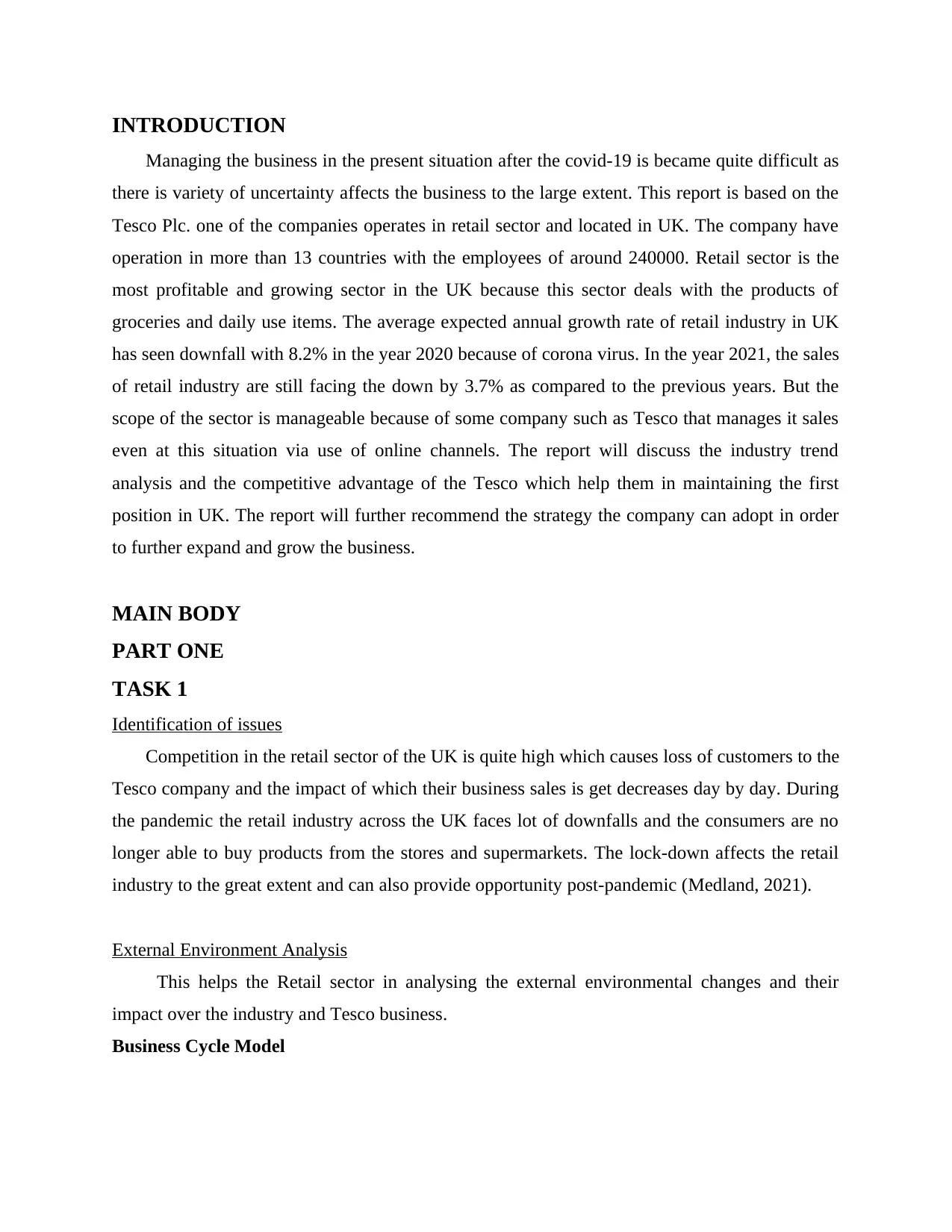
INTRODUCTION
Managing the business in the present situation after the covid-19 is became quite difficult as
there is variety of uncertainty affects the business to the large extent. This report is based on the
Tesco Plc. one of the companies operates in retail sector and located in UK. The company have
operation in more than 13 countries with the employees of around 240000. Retail sector is the
most profitable and growing sector in the UK because this sector deals with the products of
groceries and daily use items. The average expected annual growth rate of retail industry in UK
has seen downfall with 8.2% in the year 2020 because of corona virus. In the year 2021, the sales
of retail industry are still facing the down by 3.7% as compared to the previous years. But the
scope of the sector is manageable because of some company such as Tesco that manages it sales
even at this situation via use of online channels. The report will discuss the industry trend
analysis and the competitive advantage of the Tesco which help them in maintaining the first
position in UK. The report will further recommend the strategy the company can adopt in order
to further expand and grow the business.
MAIN BODY
PART ONE
TASK 1
Identification of issues
Competition in the retail sector of the UK is quite high which causes loss of customers to the
Tesco company and the impact of which their business sales is get decreases day by day. During
the pandemic the retail industry across the UK faces lot of downfalls and the consumers are no
longer able to buy products from the stores and supermarkets. The lock-down affects the retail
industry to the great extent and can also provide opportunity post-pandemic (Medland, 2021).
External Environment Analysis
This helps the Retail sector in analysing the external environmental changes and their
impact over the industry and Tesco business.
Business Cycle Model
Managing the business in the present situation after the covid-19 is became quite difficult as
there is variety of uncertainty affects the business to the large extent. This report is based on the
Tesco Plc. one of the companies operates in retail sector and located in UK. The company have
operation in more than 13 countries with the employees of around 240000. Retail sector is the
most profitable and growing sector in the UK because this sector deals with the products of
groceries and daily use items. The average expected annual growth rate of retail industry in UK
has seen downfall with 8.2% in the year 2020 because of corona virus. In the year 2021, the sales
of retail industry are still facing the down by 3.7% as compared to the previous years. But the
scope of the sector is manageable because of some company such as Tesco that manages it sales
even at this situation via use of online channels. The report will discuss the industry trend
analysis and the competitive advantage of the Tesco which help them in maintaining the first
position in UK. The report will further recommend the strategy the company can adopt in order
to further expand and grow the business.
MAIN BODY
PART ONE
TASK 1
Identification of issues
Competition in the retail sector of the UK is quite high which causes loss of customers to the
Tesco company and the impact of which their business sales is get decreases day by day. During
the pandemic the retail industry across the UK faces lot of downfalls and the consumers are no
longer able to buy products from the stores and supermarkets. The lock-down affects the retail
industry to the great extent and can also provide opportunity post-pandemic (Medland, 2021).
External Environment Analysis
This helps the Retail sector in analysing the external environmental changes and their
impact over the industry and Tesco business.
Business Cycle Model
⊘ This is a preview!⊘
Do you want full access?
Subscribe today to unlock all pages.

Trusted by 1+ million students worldwide
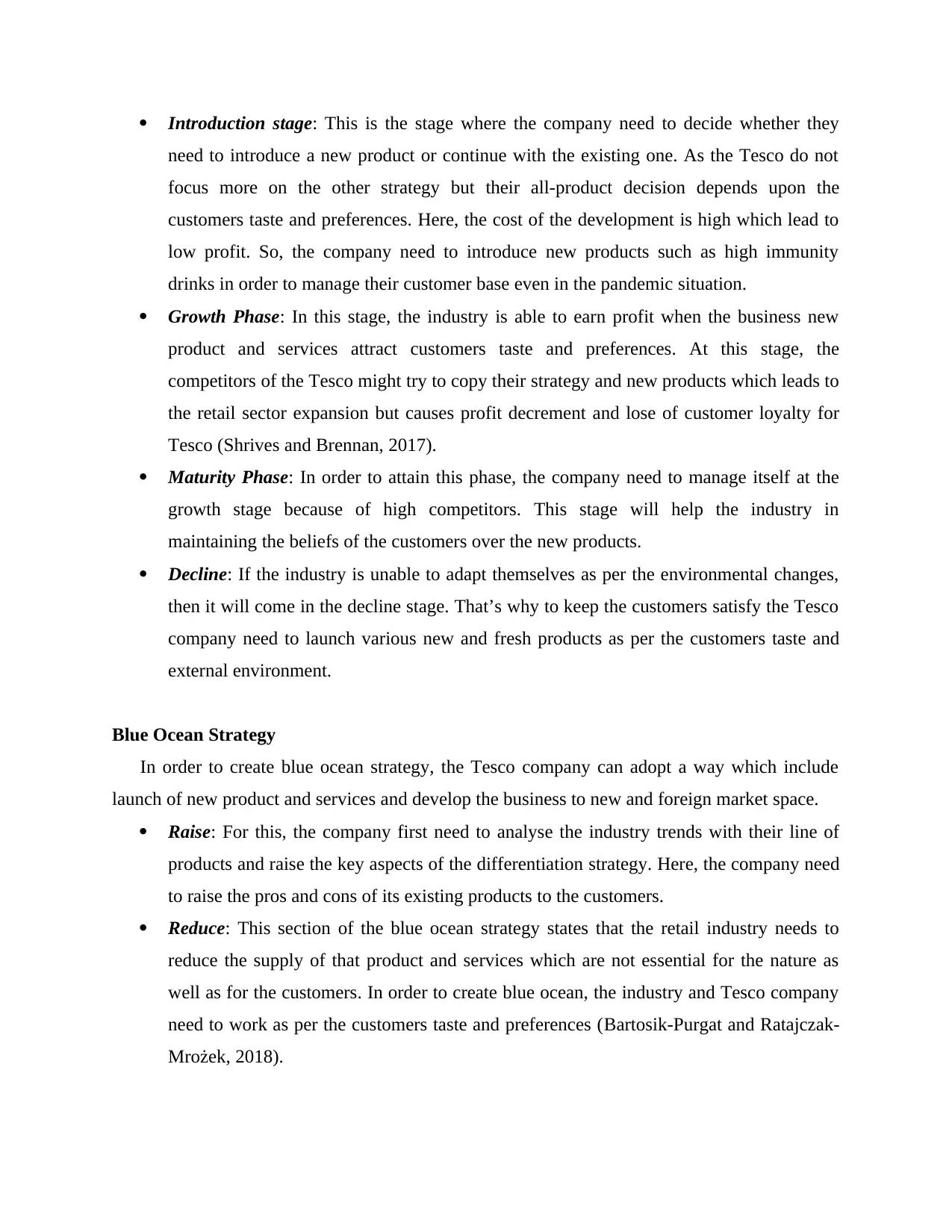
Introduction stage: This is the stage where the company need to decide whether they
need to introduce a new product or continue with the existing one. As the Tesco do not
focus more on the other strategy but their all-product decision depends upon the
customers taste and preferences. Here, the cost of the development is high which lead to
low profit. So, the company need to introduce new products such as high immunity
drinks in order to manage their customer base even in the pandemic situation.
Growth Phase: In this stage, the industry is able to earn profit when the business new
product and services attract customers taste and preferences. At this stage, the
competitors of the Tesco might try to copy their strategy and new products which leads to
the retail sector expansion but causes profit decrement and lose of customer loyalty for
Tesco (Shrives and Brennan, 2017).
Maturity Phase: In order to attain this phase, the company need to manage itself at the
growth stage because of high competitors. This stage will help the industry in
maintaining the beliefs of the customers over the new products.
Decline: If the industry is unable to adapt themselves as per the environmental changes,
then it will come in the decline stage. That’s why to keep the customers satisfy the Tesco
company need to launch various new and fresh products as per the customers taste and
external environment.
Blue Ocean Strategy
In order to create blue ocean strategy, the Tesco company can adopt a way which include
launch of new product and services and develop the business to new and foreign market space.
Raise: For this, the company first need to analyse the industry trends with their line of
products and raise the key aspects of the differentiation strategy. Here, the company need
to raise the pros and cons of its existing products to the customers.
Reduce: This section of the blue ocean strategy states that the retail industry needs to
reduce the supply of that product and services which are not essential for the nature as
well as for the customers. In order to create blue ocean, the industry and Tesco company
need to work as per the customers taste and preferences (Bartosik-Purgat and Ratajczak-
Mrożek, 2018).
need to introduce a new product or continue with the existing one. As the Tesco do not
focus more on the other strategy but their all-product decision depends upon the
customers taste and preferences. Here, the cost of the development is high which lead to
low profit. So, the company need to introduce new products such as high immunity
drinks in order to manage their customer base even in the pandemic situation.
Growth Phase: In this stage, the industry is able to earn profit when the business new
product and services attract customers taste and preferences. At this stage, the
competitors of the Tesco might try to copy their strategy and new products which leads to
the retail sector expansion but causes profit decrement and lose of customer loyalty for
Tesco (Shrives and Brennan, 2017).
Maturity Phase: In order to attain this phase, the company need to manage itself at the
growth stage because of high competitors. This stage will help the industry in
maintaining the beliefs of the customers over the new products.
Decline: If the industry is unable to adapt themselves as per the environmental changes,
then it will come in the decline stage. That’s why to keep the customers satisfy the Tesco
company need to launch various new and fresh products as per the customers taste and
external environment.
Blue Ocean Strategy
In order to create blue ocean strategy, the Tesco company can adopt a way which include
launch of new product and services and develop the business to new and foreign market space.
Raise: For this, the company first need to analyse the industry trends with their line of
products and raise the key aspects of the differentiation strategy. Here, the company need
to raise the pros and cons of its existing products to the customers.
Reduce: This section of the blue ocean strategy states that the retail industry needs to
reduce the supply of that product and services which are not essential for the nature as
well as for the customers. In order to create blue ocean, the industry and Tesco company
need to work as per the customers taste and preferences (Bartosik-Purgat and Ratajczak-
Mrożek, 2018).
Paraphrase This Document
Need a fresh take? Get an instant paraphrase of this document with our AI Paraphraser
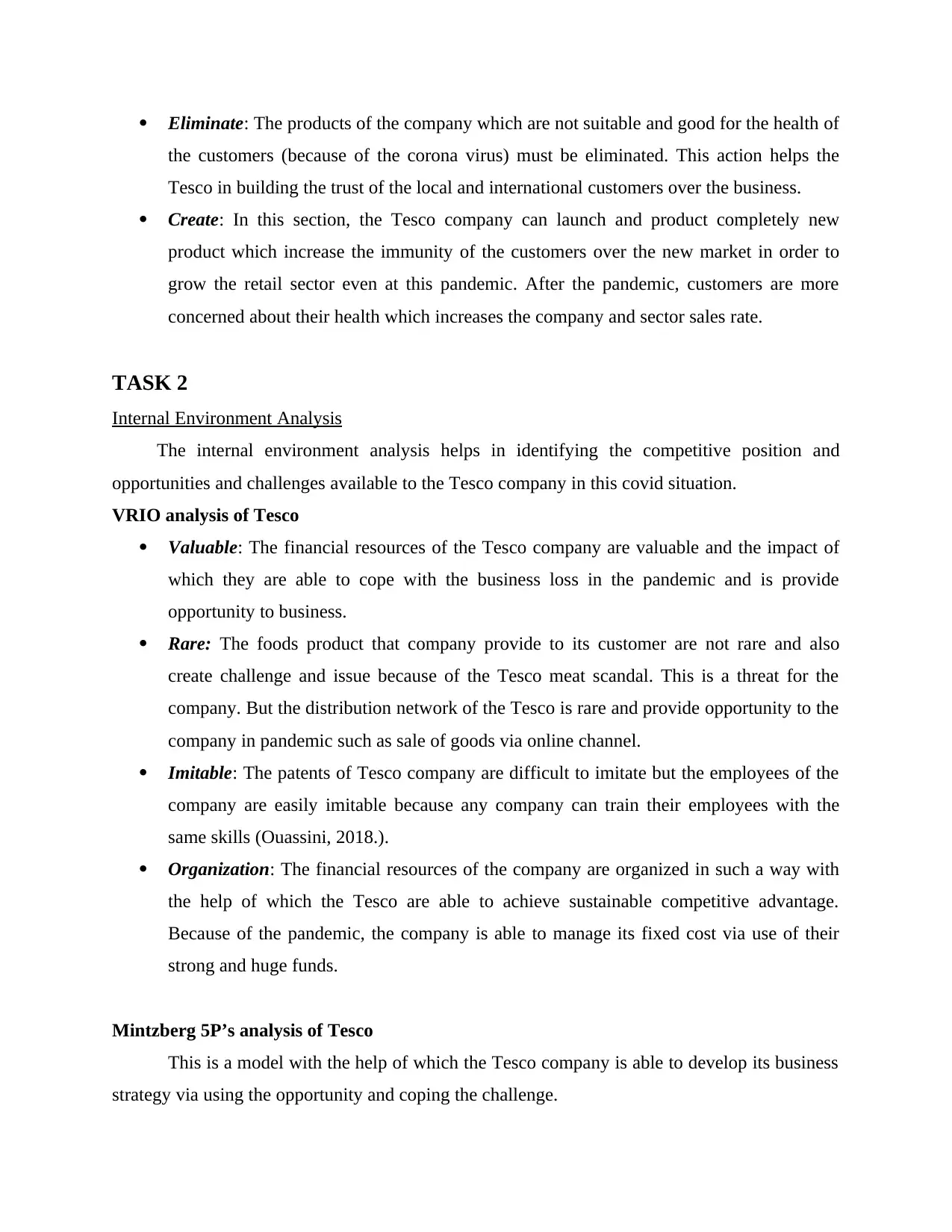
Eliminate: The products of the company which are not suitable and good for the health of
the customers (because of the corona virus) must be eliminated. This action helps the
Tesco in building the trust of the local and international customers over the business.
Create: In this section, the Tesco company can launch and product completely new
product which increase the immunity of the customers over the new market in order to
grow the retail sector even at this pandemic. After the pandemic, customers are more
concerned about their health which increases the company and sector sales rate.
TASK 2
Internal Environment Analysis
The internal environment analysis helps in identifying the competitive position and
opportunities and challenges available to the Tesco company in this covid situation.
VRIO analysis of Tesco
Valuable: The financial resources of the Tesco company are valuable and the impact of
which they are able to cope with the business loss in the pandemic and is provide
opportunity to business.
Rare: The foods product that company provide to its customer are not rare and also
create challenge and issue because of the Tesco meat scandal. This is a threat for the
company. But the distribution network of the Tesco is rare and provide opportunity to the
company in pandemic such as sale of goods via online channel.
Imitable: The patents of Tesco company are difficult to imitate but the employees of the
company are easily imitable because any company can train their employees with the
same skills (Ouassini, 2018.).
Organization: The financial resources of the company are organized in such a way with
the help of which the Tesco are able to achieve sustainable competitive advantage.
Because of the pandemic, the company is able to manage its fixed cost via use of their
strong and huge funds.
Mintzberg 5P’s analysis of Tesco
This is a model with the help of which the Tesco company is able to develop its business
strategy via using the opportunity and coping the challenge.
the customers (because of the corona virus) must be eliminated. This action helps the
Tesco in building the trust of the local and international customers over the business.
Create: In this section, the Tesco company can launch and product completely new
product which increase the immunity of the customers over the new market in order to
grow the retail sector even at this pandemic. After the pandemic, customers are more
concerned about their health which increases the company and sector sales rate.
TASK 2
Internal Environment Analysis
The internal environment analysis helps in identifying the competitive position and
opportunities and challenges available to the Tesco company in this covid situation.
VRIO analysis of Tesco
Valuable: The financial resources of the Tesco company are valuable and the impact of
which they are able to cope with the business loss in the pandemic and is provide
opportunity to business.
Rare: The foods product that company provide to its customer are not rare and also
create challenge and issue because of the Tesco meat scandal. This is a threat for the
company. But the distribution network of the Tesco is rare and provide opportunity to the
company in pandemic such as sale of goods via online channel.
Imitable: The patents of Tesco company are difficult to imitate but the employees of the
company are easily imitable because any company can train their employees with the
same skills (Ouassini, 2018.).
Organization: The financial resources of the company are organized in such a way with
the help of which the Tesco are able to achieve sustainable competitive advantage.
Because of the pandemic, the company is able to manage its fixed cost via use of their
strong and huge funds.
Mintzberg 5P’s analysis of Tesco
This is a model with the help of which the Tesco company is able to develop its business
strategy via using the opportunity and coping the challenge.
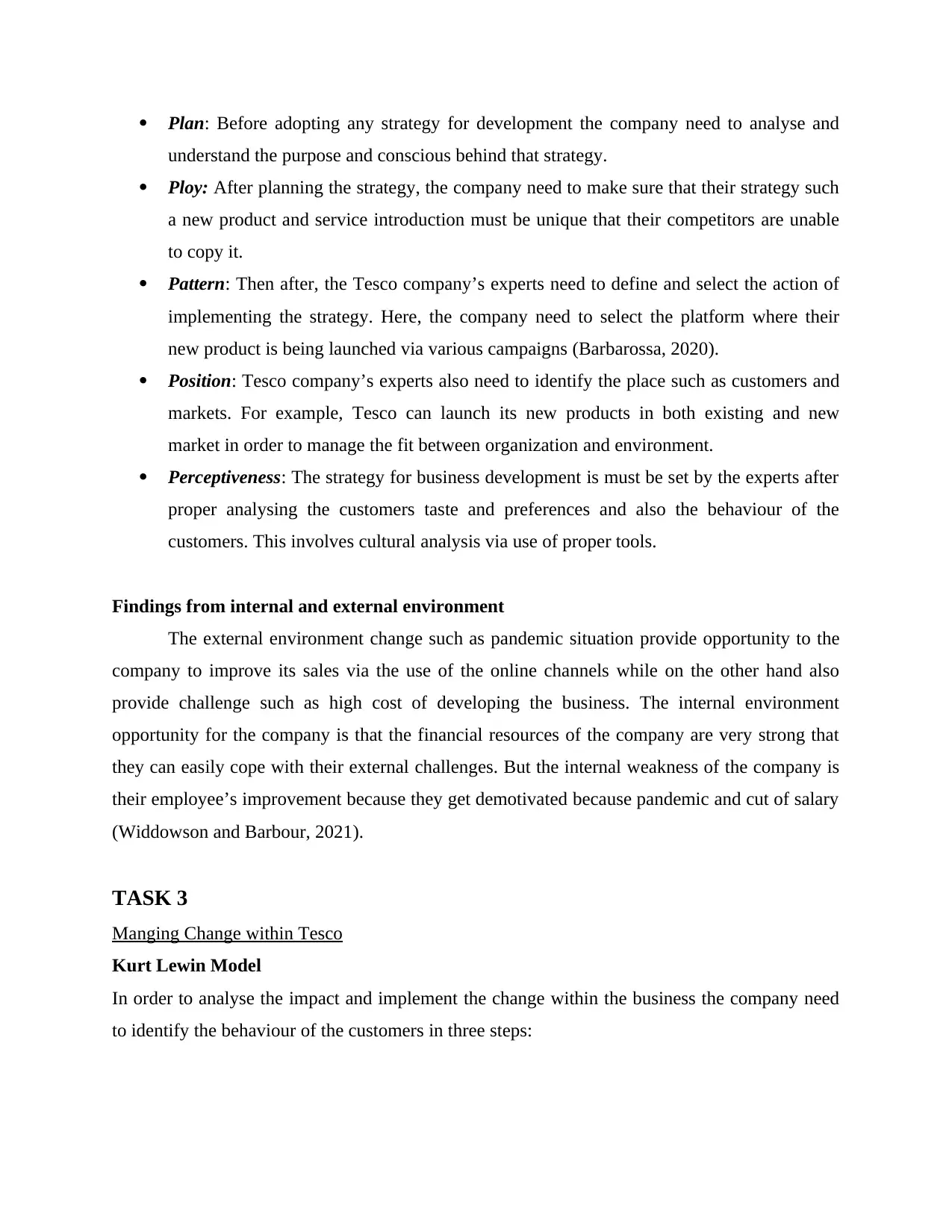
Plan: Before adopting any strategy for development the company need to analyse and
understand the purpose and conscious behind that strategy.
Ploy: After planning the strategy, the company need to make sure that their strategy such
a new product and service introduction must be unique that their competitors are unable
to copy it.
Pattern: Then after, the Tesco company’s experts need to define and select the action of
implementing the strategy. Here, the company need to select the platform where their
new product is being launched via various campaigns (Barbarossa, 2020).
Position: Tesco company’s experts also need to identify the place such as customers and
markets. For example, Tesco can launch its new products in both existing and new
market in order to manage the fit between organization and environment.
Perceptiveness: The strategy for business development is must be set by the experts after
proper analysing the customers taste and preferences and also the behaviour of the
customers. This involves cultural analysis via use of proper tools.
Findings from internal and external environment
The external environment change such as pandemic situation provide opportunity to the
company to improve its sales via the use of the online channels while on the other hand also
provide challenge such as high cost of developing the business. The internal environment
opportunity for the company is that the financial resources of the company are very strong that
they can easily cope with their external challenges. But the internal weakness of the company is
their employee’s improvement because they get demotivated because pandemic and cut of salary
(Widdowson and Barbour, 2021).
TASK 3
Manging Change within Tesco
Kurt Lewin Model
In order to analyse the impact and implement the change within the business the company need
to identify the behaviour of the customers in three steps:
understand the purpose and conscious behind that strategy.
Ploy: After planning the strategy, the company need to make sure that their strategy such
a new product and service introduction must be unique that their competitors are unable
to copy it.
Pattern: Then after, the Tesco company’s experts need to define and select the action of
implementing the strategy. Here, the company need to select the platform where their
new product is being launched via various campaigns (Barbarossa, 2020).
Position: Tesco company’s experts also need to identify the place such as customers and
markets. For example, Tesco can launch its new products in both existing and new
market in order to manage the fit between organization and environment.
Perceptiveness: The strategy for business development is must be set by the experts after
proper analysing the customers taste and preferences and also the behaviour of the
customers. This involves cultural analysis via use of proper tools.
Findings from internal and external environment
The external environment change such as pandemic situation provide opportunity to the
company to improve its sales via the use of the online channels while on the other hand also
provide challenge such as high cost of developing the business. The internal environment
opportunity for the company is that the financial resources of the company are very strong that
they can easily cope with their external challenges. But the internal weakness of the company is
their employee’s improvement because they get demotivated because pandemic and cut of salary
(Widdowson and Barbour, 2021).
TASK 3
Manging Change within Tesco
Kurt Lewin Model
In order to analyse the impact and implement the change within the business the company need
to identify the behaviour of the customers in three steps:
⊘ This is a preview!⊘
Do you want full access?
Subscribe today to unlock all pages.

Trusted by 1+ million students worldwide
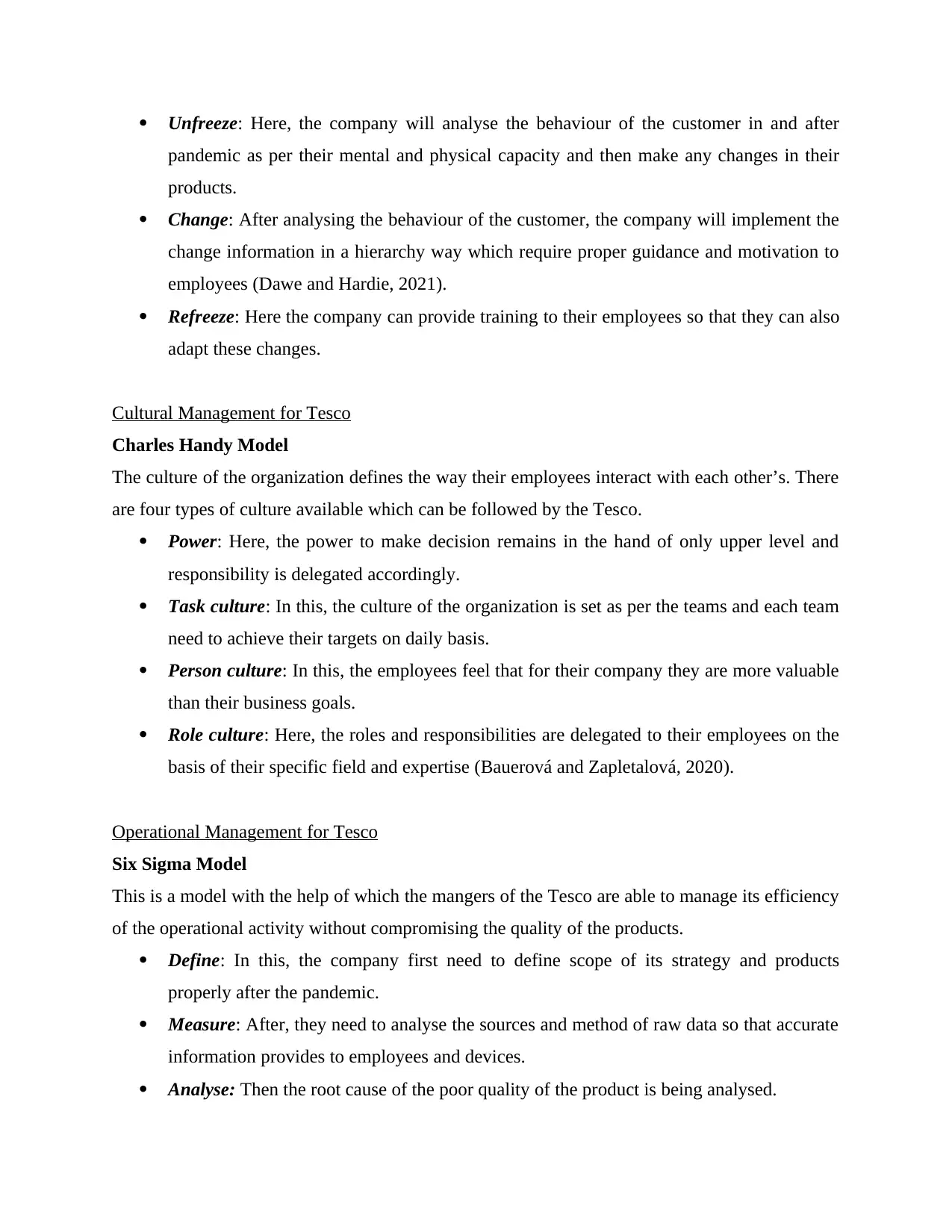
Unfreeze: Here, the company will analyse the behaviour of the customer in and after
pandemic as per their mental and physical capacity and then make any changes in their
products.
Change: After analysing the behaviour of the customer, the company will implement the
change information in a hierarchy way which require proper guidance and motivation to
employees (Dawe and Hardie, 2021).
Refreeze: Here the company can provide training to their employees so that they can also
adapt these changes.
Cultural Management for Tesco
Charles Handy Model
The culture of the organization defines the way their employees interact with each other’s. There
are four types of culture available which can be followed by the Tesco.
Power: Here, the power to make decision remains in the hand of only upper level and
responsibility is delegated accordingly.
Task culture: In this, the culture of the organization is set as per the teams and each team
need to achieve their targets on daily basis.
Person culture: In this, the employees feel that for their company they are more valuable
than their business goals.
Role culture: Here, the roles and responsibilities are delegated to their employees on the
basis of their specific field and expertise (Bauerová and Zapletalová, 2020).
Operational Management for Tesco
Six Sigma Model
This is a model with the help of which the mangers of the Tesco are able to manage its efficiency
of the operational activity without compromising the quality of the products.
Define: In this, the company first need to define scope of its strategy and products
properly after the pandemic.
Measure: After, they need to analyse the sources and method of raw data so that accurate
information provides to employees and devices.
Analyse: Then the root cause of the poor quality of the product is being analysed.
pandemic as per their mental and physical capacity and then make any changes in their
products.
Change: After analysing the behaviour of the customer, the company will implement the
change information in a hierarchy way which require proper guidance and motivation to
employees (Dawe and Hardie, 2021).
Refreeze: Here the company can provide training to their employees so that they can also
adapt these changes.
Cultural Management for Tesco
Charles Handy Model
The culture of the organization defines the way their employees interact with each other’s. There
are four types of culture available which can be followed by the Tesco.
Power: Here, the power to make decision remains in the hand of only upper level and
responsibility is delegated accordingly.
Task culture: In this, the culture of the organization is set as per the teams and each team
need to achieve their targets on daily basis.
Person culture: In this, the employees feel that for their company they are more valuable
than their business goals.
Role culture: Here, the roles and responsibilities are delegated to their employees on the
basis of their specific field and expertise (Bauerová and Zapletalová, 2020).
Operational Management for Tesco
Six Sigma Model
This is a model with the help of which the mangers of the Tesco are able to manage its efficiency
of the operational activity without compromising the quality of the products.
Define: In this, the company first need to define scope of its strategy and products
properly after the pandemic.
Measure: After, they need to analyse the sources and method of raw data so that accurate
information provides to employees and devices.
Analyse: Then the root cause of the poor quality of the product is being analysed.
Paraphrase This Document
Need a fresh take? Get an instant paraphrase of this document with our AI Paraphraser
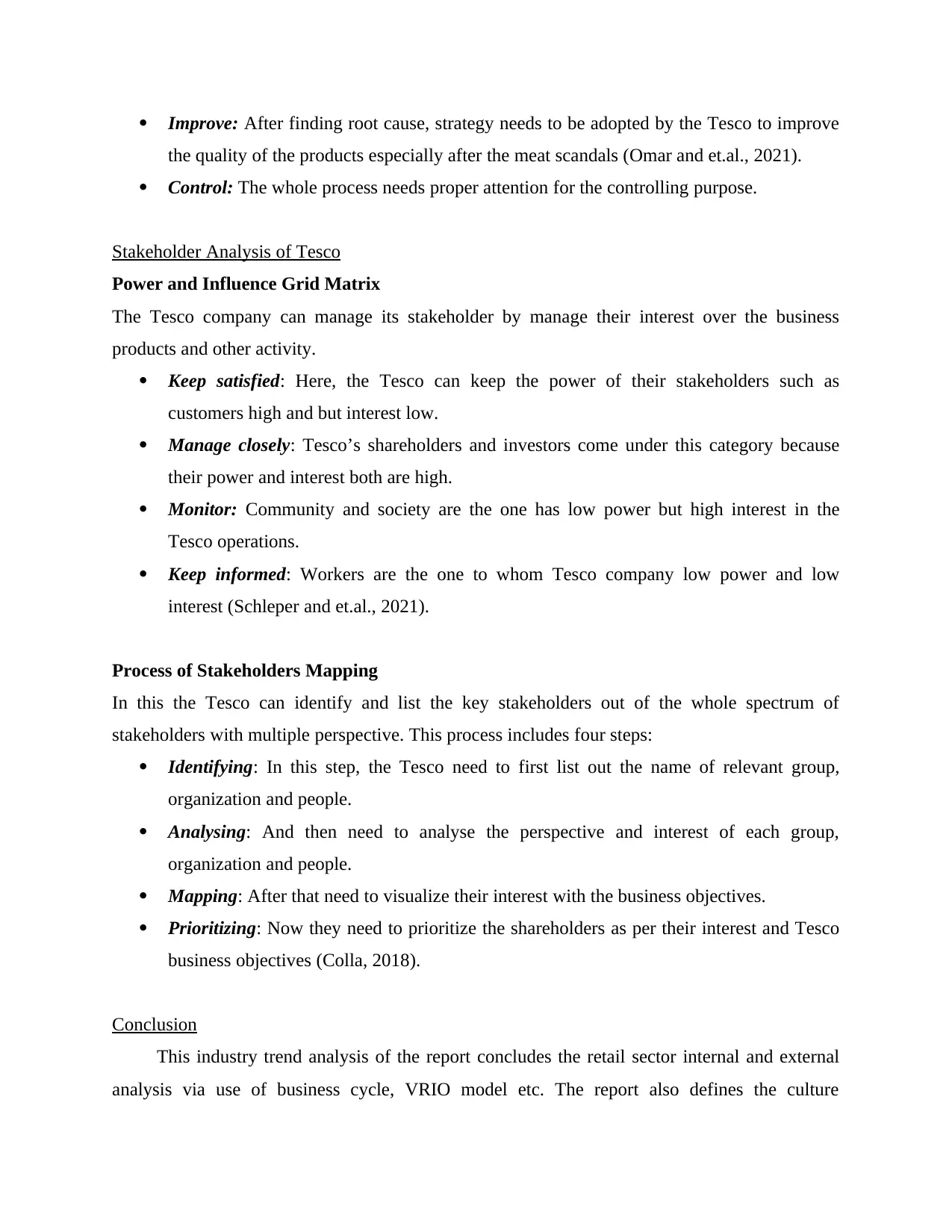
Improve: After finding root cause, strategy needs to be adopted by the Tesco to improve
the quality of the products especially after the meat scandals (Omar and et.al., 2021).
Control: The whole process needs proper attention for the controlling purpose.
Stakeholder Analysis of Tesco
Power and Influence Grid Matrix
The Tesco company can manage its stakeholder by manage their interest over the business
products and other activity.
Keep satisfied: Here, the Tesco can keep the power of their stakeholders such as
customers high and but interest low.
Manage closely: Tesco’s shareholders and investors come under this category because
their power and interest both are high.
Monitor: Community and society are the one has low power but high interest in the
Tesco operations.
Keep informed: Workers are the one to whom Tesco company low power and low
interest (Schleper and et.al., 2021).
Process of Stakeholders Mapping
In this the Tesco can identify and list the key stakeholders out of the whole spectrum of
stakeholders with multiple perspective. This process includes four steps:
Identifying: In this step, the Tesco need to first list out the name of relevant group,
organization and people.
Analysing: And then need to analyse the perspective and interest of each group,
organization and people.
Mapping: After that need to visualize their interest with the business objectives.
Prioritizing: Now they need to prioritize the shareholders as per their interest and Tesco
business objectives (Colla, 2018).
Conclusion
This industry trend analysis of the report concludes the retail sector internal and external
analysis via use of business cycle, VRIO model etc. The report also defines the culture
the quality of the products especially after the meat scandals (Omar and et.al., 2021).
Control: The whole process needs proper attention for the controlling purpose.
Stakeholder Analysis of Tesco
Power and Influence Grid Matrix
The Tesco company can manage its stakeholder by manage their interest over the business
products and other activity.
Keep satisfied: Here, the Tesco can keep the power of their stakeholders such as
customers high and but interest low.
Manage closely: Tesco’s shareholders and investors come under this category because
their power and interest both are high.
Monitor: Community and society are the one has low power but high interest in the
Tesco operations.
Keep informed: Workers are the one to whom Tesco company low power and low
interest (Schleper and et.al., 2021).
Process of Stakeholders Mapping
In this the Tesco can identify and list the key stakeholders out of the whole spectrum of
stakeholders with multiple perspective. This process includes four steps:
Identifying: In this step, the Tesco need to first list out the name of relevant group,
organization and people.
Analysing: And then need to analyse the perspective and interest of each group,
organization and people.
Mapping: After that need to visualize their interest with the business objectives.
Prioritizing: Now they need to prioritize the shareholders as per their interest and Tesco
business objectives (Colla, 2018).
Conclusion
This industry trend analysis of the report concludes the retail sector internal and external
analysis via use of business cycle, VRIO model etc. The report also defines the culture
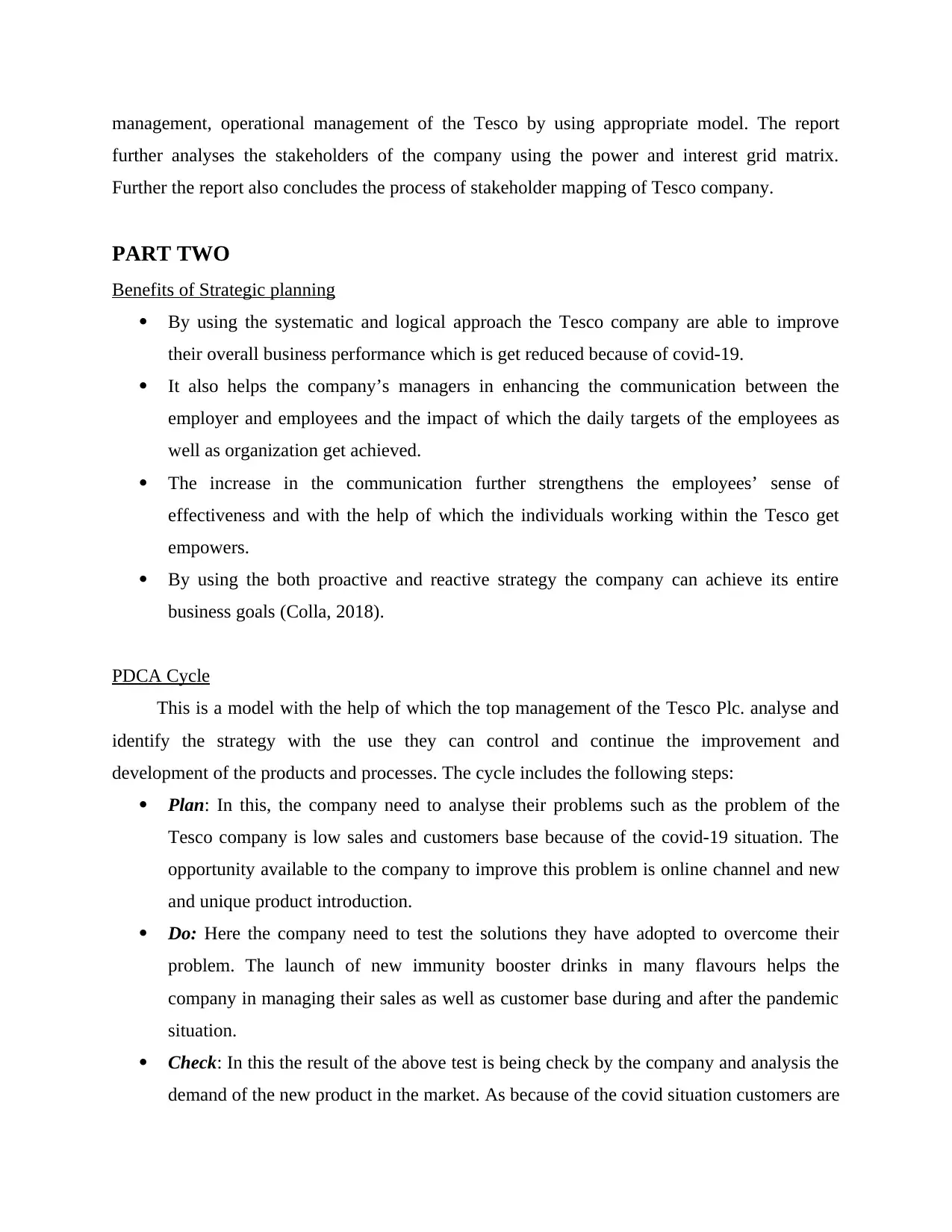
management, operational management of the Tesco by using appropriate model. The report
further analyses the stakeholders of the company using the power and interest grid matrix.
Further the report also concludes the process of stakeholder mapping of Tesco company.
PART TWO
Benefits of Strategic planning
By using the systematic and logical approach the Tesco company are able to improve
their overall business performance which is get reduced because of covid-19.
It also helps the company’s managers in enhancing the communication between the
employer and employees and the impact of which the daily targets of the employees as
well as organization get achieved.
The increase in the communication further strengthens the employees’ sense of
effectiveness and with the help of which the individuals working within the Tesco get
empowers.
By using the both proactive and reactive strategy the company can achieve its entire
business goals (Colla, 2018).
PDCA Cycle
This is a model with the help of which the top management of the Tesco Plc. analyse and
identify the strategy with the use they can control and continue the improvement and
development of the products and processes. The cycle includes the following steps:
Plan: In this, the company need to analyse their problems such as the problem of the
Tesco company is low sales and customers base because of the covid-19 situation. The
opportunity available to the company to improve this problem is online channel and new
and unique product introduction.
Do: Here the company need to test the solutions they have adopted to overcome their
problem. The launch of new immunity booster drinks in many flavours helps the
company in managing their sales as well as customer base during and after the pandemic
situation.
Check: In this the result of the above test is being check by the company and analysis the
demand of the new product in the market. As because of the covid situation customers are
further analyses the stakeholders of the company using the power and interest grid matrix.
Further the report also concludes the process of stakeholder mapping of Tesco company.
PART TWO
Benefits of Strategic planning
By using the systematic and logical approach the Tesco company are able to improve
their overall business performance which is get reduced because of covid-19.
It also helps the company’s managers in enhancing the communication between the
employer and employees and the impact of which the daily targets of the employees as
well as organization get achieved.
The increase in the communication further strengthens the employees’ sense of
effectiveness and with the help of which the individuals working within the Tesco get
empowers.
By using the both proactive and reactive strategy the company can achieve its entire
business goals (Colla, 2018).
PDCA Cycle
This is a model with the help of which the top management of the Tesco Plc. analyse and
identify the strategy with the use they can control and continue the improvement and
development of the products and processes. The cycle includes the following steps:
Plan: In this, the company need to analyse their problems such as the problem of the
Tesco company is low sales and customers base because of the covid-19 situation. The
opportunity available to the company to improve this problem is online channel and new
and unique product introduction.
Do: Here the company need to test the solutions they have adopted to overcome their
problem. The launch of new immunity booster drinks in many flavours helps the
company in managing their sales as well as customer base during and after the pandemic
situation.
Check: In this the result of the above test is being check by the company and analysis the
demand of the new product in the market. As because of the covid situation customers are
⊘ This is a preview!⊘
Do you want full access?
Subscribe today to unlock all pages.

Trusted by 1+ million students worldwide
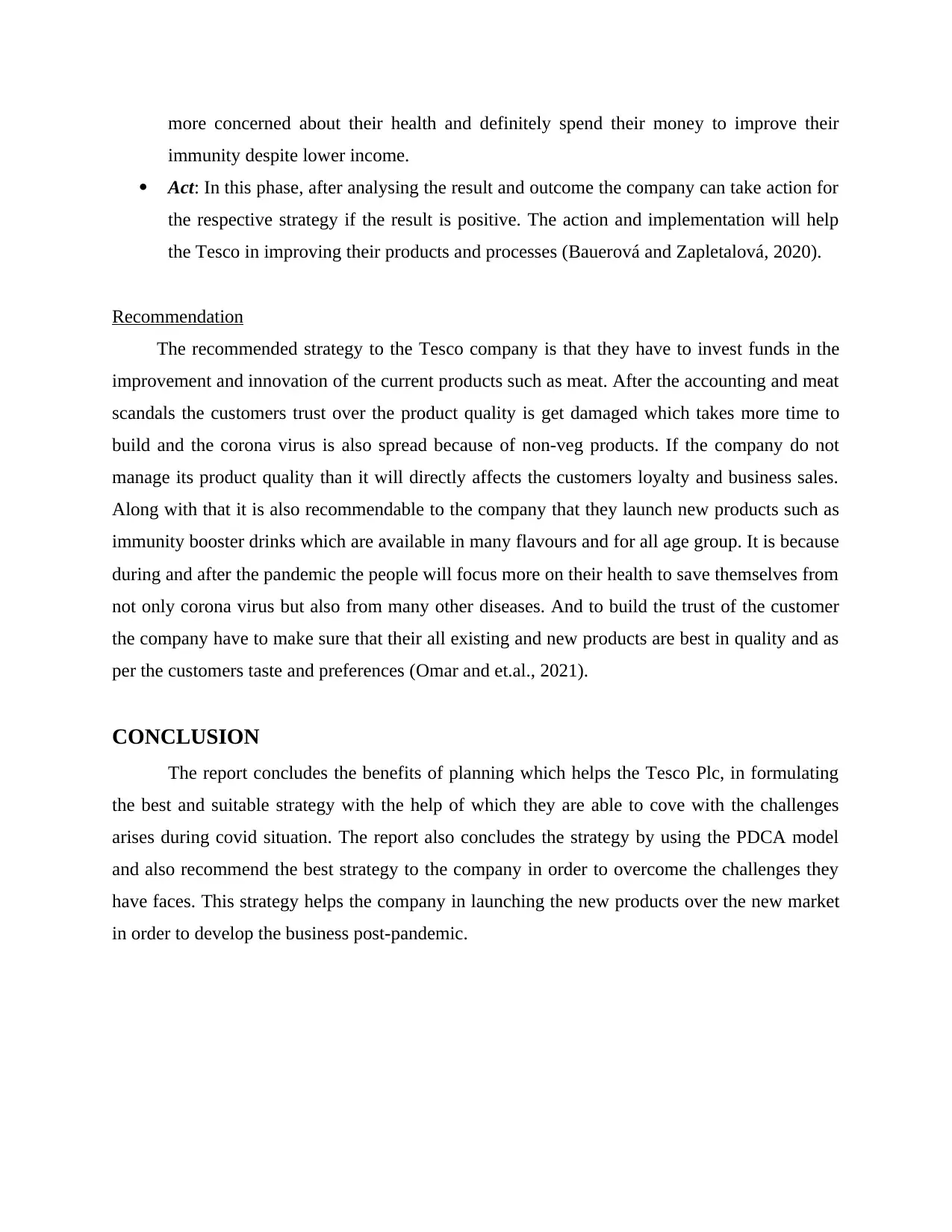
more concerned about their health and definitely spend their money to improve their
immunity despite lower income.
Act: In this phase, after analysing the result and outcome the company can take action for
the respective strategy if the result is positive. The action and implementation will help
the Tesco in improving their products and processes (Bauerová and Zapletalová, 2020).
Recommendation
The recommended strategy to the Tesco company is that they have to invest funds in the
improvement and innovation of the current products such as meat. After the accounting and meat
scandals the customers trust over the product quality is get damaged which takes more time to
build and the corona virus is also spread because of non-veg products. If the company do not
manage its product quality than it will directly affects the customers loyalty and business sales.
Along with that it is also recommendable to the company that they launch new products such as
immunity booster drinks which are available in many flavours and for all age group. It is because
during and after the pandemic the people will focus more on their health to save themselves from
not only corona virus but also from many other diseases. And to build the trust of the customer
the company have to make sure that their all existing and new products are best in quality and as
per the customers taste and preferences (Omar and et.al., 2021).
CONCLUSION
The report concludes the benefits of planning which helps the Tesco Plc, in formulating
the best and suitable strategy with the help of which they are able to cove with the challenges
arises during covid situation. The report also concludes the strategy by using the PDCA model
and also recommend the best strategy to the company in order to overcome the challenges they
have faces. This strategy helps the company in launching the new products over the new market
in order to develop the business post-pandemic.
immunity despite lower income.
Act: In this phase, after analysing the result and outcome the company can take action for
the respective strategy if the result is positive. The action and implementation will help
the Tesco in improving their products and processes (Bauerová and Zapletalová, 2020).
Recommendation
The recommended strategy to the Tesco company is that they have to invest funds in the
improvement and innovation of the current products such as meat. After the accounting and meat
scandals the customers trust over the product quality is get damaged which takes more time to
build and the corona virus is also spread because of non-veg products. If the company do not
manage its product quality than it will directly affects the customers loyalty and business sales.
Along with that it is also recommendable to the company that they launch new products such as
immunity booster drinks which are available in many flavours and for all age group. It is because
during and after the pandemic the people will focus more on their health to save themselves from
not only corona virus but also from many other diseases. And to build the trust of the customer
the company have to make sure that their all existing and new products are best in quality and as
per the customers taste and preferences (Omar and et.al., 2021).
CONCLUSION
The report concludes the benefits of planning which helps the Tesco Plc, in formulating
the best and suitable strategy with the help of which they are able to cove with the challenges
arises during covid situation. The report also concludes the strategy by using the PDCA model
and also recommend the best strategy to the company in order to overcome the challenges they
have faces. This strategy helps the company in launching the new products over the new market
in order to develop the business post-pandemic.
Paraphrase This Document
Need a fresh take? Get an instant paraphrase of this document with our AI Paraphraser
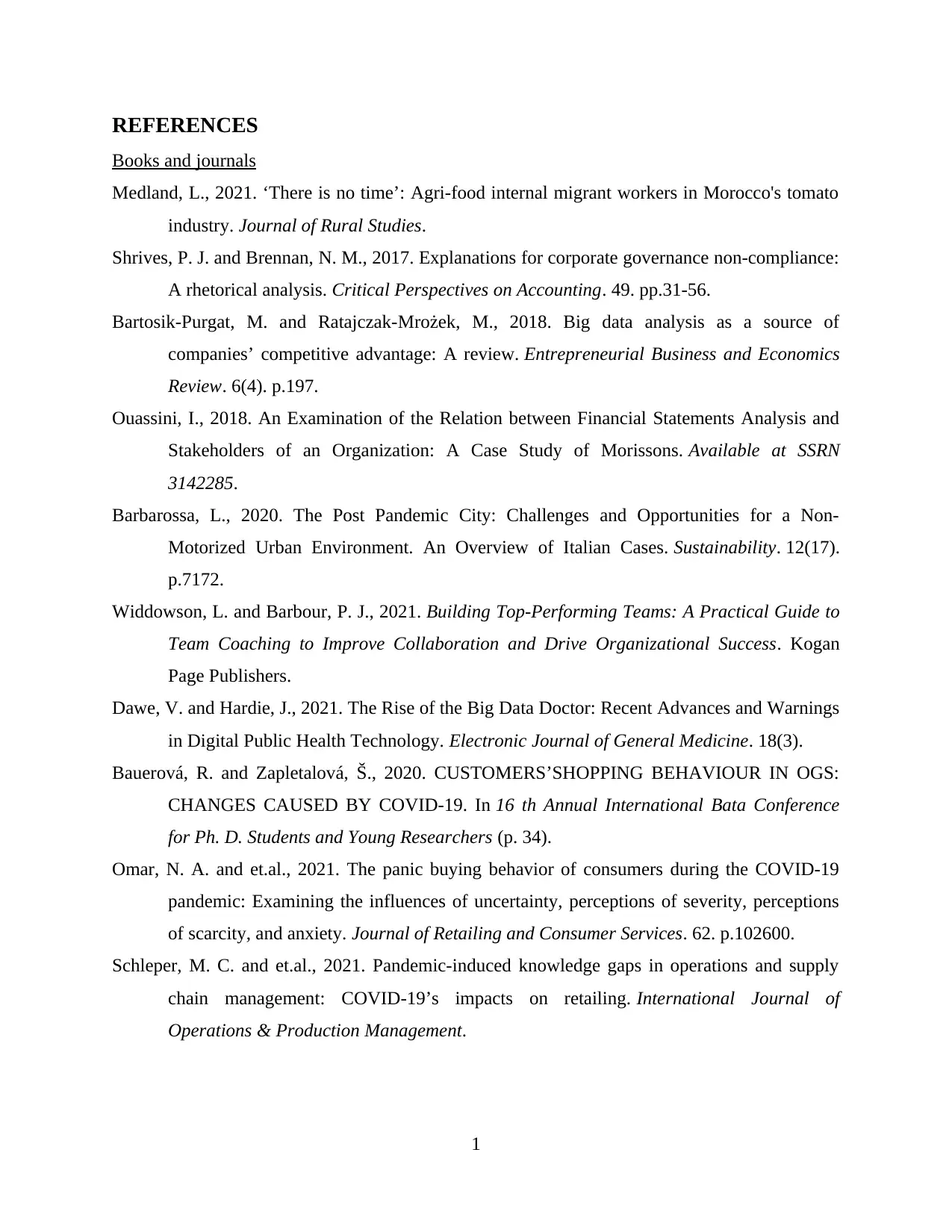
REFERENCES
Books and journals
Medland, L., 2021. ‘There is no time’: Agri-food internal migrant workers in Morocco's tomato
industry. Journal of Rural Studies.
Shrives, P. J. and Brennan, N. M., 2017. Explanations for corporate governance non-compliance:
A rhetorical analysis. Critical Perspectives on Accounting. 49. pp.31-56.
Bartosik-Purgat, M. and Ratajczak-Mrożek, M., 2018. Big data analysis as a source of
companies’ competitive advantage: A review. Entrepreneurial Business and Economics
Review. 6(4). p.197.
Ouassini, I., 2018. An Examination of the Relation between Financial Statements Analysis and
Stakeholders of an Organization: A Case Study of Morissons. Available at SSRN
3142285.
Barbarossa, L., 2020. The Post Pandemic City: Challenges and Opportunities for a Non-
Motorized Urban Environment. An Overview of Italian Cases. Sustainability. 12(17).
p.7172.
Widdowson, L. and Barbour, P. J., 2021. Building Top-Performing Teams: A Practical Guide to
Team Coaching to Improve Collaboration and Drive Organizational Success. Kogan
Page Publishers.
Dawe, V. and Hardie, J., 2021. The Rise of the Big Data Doctor: Recent Advances and Warnings
in Digital Public Health Technology. Electronic Journal of General Medicine. 18(3).
Bauerová, R. and Zapletalová, Š., 2020. CUSTOMERS’SHOPPING BEHAVIOUR IN OGS:
CHANGES CAUSED BY COVID-19. In 16 th Annual International Bata Conference
for Ph. D. Students and Young Researchers (p. 34).
Omar, N. A. and et.al., 2021. The panic buying behavior of consumers during the COVID-19
pandemic: Examining the influences of uncertainty, perceptions of severity, perceptions
of scarcity, and anxiety. Journal of Retailing and Consumer Services. 62. p.102600.
Schleper, M. C. and et.al., 2021. Pandemic-induced knowledge gaps in operations and supply
chain management: COVID-19’s impacts on retailing. International Journal of
Operations & Production Management.
1
Books and journals
Medland, L., 2021. ‘There is no time’: Agri-food internal migrant workers in Morocco's tomato
industry. Journal of Rural Studies.
Shrives, P. J. and Brennan, N. M., 2017. Explanations for corporate governance non-compliance:
A rhetorical analysis. Critical Perspectives on Accounting. 49. pp.31-56.
Bartosik-Purgat, M. and Ratajczak-Mrożek, M., 2018. Big data analysis as a source of
companies’ competitive advantage: A review. Entrepreneurial Business and Economics
Review. 6(4). p.197.
Ouassini, I., 2018. An Examination of the Relation between Financial Statements Analysis and
Stakeholders of an Organization: A Case Study of Morissons. Available at SSRN
3142285.
Barbarossa, L., 2020. The Post Pandemic City: Challenges and Opportunities for a Non-
Motorized Urban Environment. An Overview of Italian Cases. Sustainability. 12(17).
p.7172.
Widdowson, L. and Barbour, P. J., 2021. Building Top-Performing Teams: A Practical Guide to
Team Coaching to Improve Collaboration and Drive Organizational Success. Kogan
Page Publishers.
Dawe, V. and Hardie, J., 2021. The Rise of the Big Data Doctor: Recent Advances and Warnings
in Digital Public Health Technology. Electronic Journal of General Medicine. 18(3).
Bauerová, R. and Zapletalová, Š., 2020. CUSTOMERS’SHOPPING BEHAVIOUR IN OGS:
CHANGES CAUSED BY COVID-19. In 16 th Annual International Bata Conference
for Ph. D. Students and Young Researchers (p. 34).
Omar, N. A. and et.al., 2021. The panic buying behavior of consumers during the COVID-19
pandemic: Examining the influences of uncertainty, perceptions of severity, perceptions
of scarcity, and anxiety. Journal of Retailing and Consumer Services. 62. p.102600.
Schleper, M. C. and et.al., 2021. Pandemic-induced knowledge gaps in operations and supply
chain management: COVID-19’s impacts on retailing. International Journal of
Operations & Production Management.
1
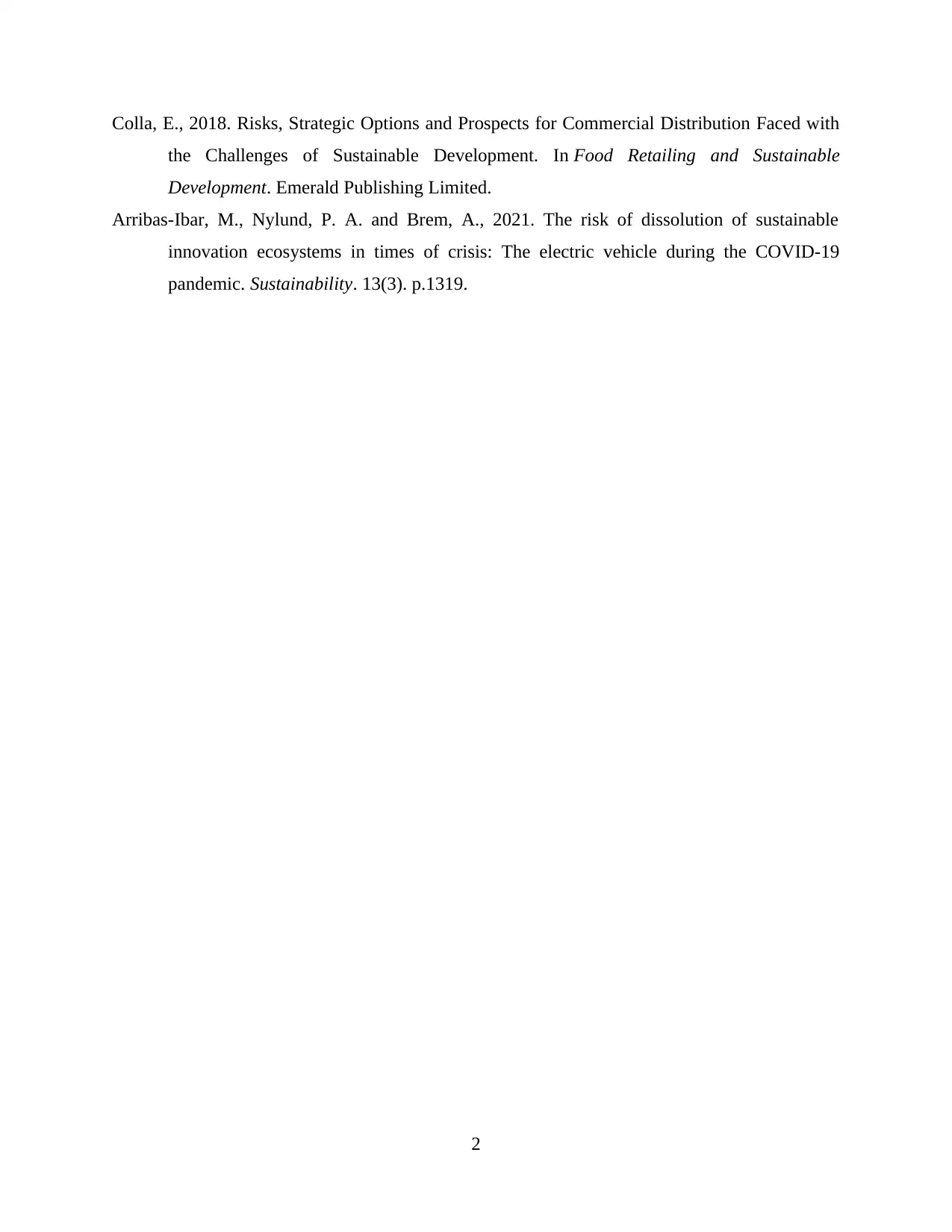
Colla, E., 2018. Risks, Strategic Options and Prospects for Commercial Distribution Faced with
the Challenges of Sustainable Development. In Food Retailing and Sustainable
Development. Emerald Publishing Limited.
Arribas-Ibar, M., Nylund, P. A. and Brem, A., 2021. The risk of dissolution of sustainable
innovation ecosystems in times of crisis: The electric vehicle during the COVID-19
pandemic. Sustainability. 13(3). p.1319.
2
the Challenges of Sustainable Development. In Food Retailing and Sustainable
Development. Emerald Publishing Limited.
Arribas-Ibar, M., Nylund, P. A. and Brem, A., 2021. The risk of dissolution of sustainable
innovation ecosystems in times of crisis: The electric vehicle during the COVID-19
pandemic. Sustainability. 13(3). p.1319.
2
⊘ This is a preview!⊘
Do you want full access?
Subscribe today to unlock all pages.

Trusted by 1+ million students worldwide
1 out of 12
Related Documents
Your All-in-One AI-Powered Toolkit for Academic Success.
+13062052269
info@desklib.com
Available 24*7 on WhatsApp / Email
![[object Object]](/_next/static/media/star-bottom.7253800d.svg)
Unlock your academic potential
© 2024 | Zucol Services PVT LTD | All rights reserved.


